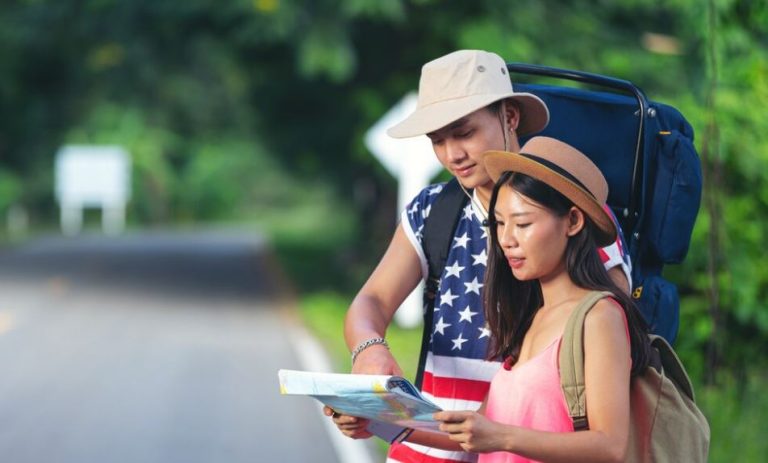The United States of America continues to draw tourists from all over the world because it is a nation of striking contrasts, a mosaic of cultures, climates, and cuisines. However, in recent months, increasing apprehension has surfaced in forums, embassies, and even at dinner tables. Is going to the United States in 2025 really safe?
Despite its apparent simplicity, this question leads to a complex discussion. Travelers are feeling a mixture of opportunity and uncertainty, much like when they watch clouds gather on a sunny day. Political polarization, digital privacy at borders, and gun violence have all become significantly more of a concern. The reality on the ground, however, paints a different, more complex picture, one that is molded by planning rather than fear.
U.S. Travel Safety Snapshot (2025)
| Category | Details |
|---|---|
| Overall Risk Level | Moderate – Normal precautions recommended (Gov.uk) |
| Gun Violence | Extremely rare for tourists; avoid high-crime zones |
| LGBTQ+ Traveler Status | Mixed – Welcoming in most urban centers, restricted in select states |
| Border & Airport Detentions | Increased scrutiny, especially for dual nationals and trans travelers |
| Device & Data Inspections | Allowed by Customs; be selective with sensitive data |
| Natural Disasters | Seasonal risks: hurricanes, wildfires, snowstorms |
| Common Safety Tips | Follow local laws, avoid political discussions, keep devices clean |
When News Stories Take Priority Over Hospitality
Public anxiety has increased in recent days due to a flurry of concerning stories, from border detentions to mass shootings. Questions abound on travel forums, and nations like Finland, Germany, and Ireland have issued specific advisories. For instance, trans passengers who use the gender marker “X” are now advised to verify entry requirements prior to flying into the United States.
However, this growing anxiety frequently obscures the obvious reality: most visitors still find their time in the USA to be easy and enjoyable. Toronto Metropolitan University professor Frédéric Dimanche drew attention to the remarkably similar patterns to post-COVID paranoia, where fear fueled by the media greatly outweighed real danger.
Comprehending the Story of Gun Violence
It is true that America has a different relationship with firearms than any other Western nation. However, it’s critical to comprehend the background. Despite making headlines, violent crime and gun-related incidents are statistically unlikely to occur among tourists. They usually take place late at night, in very specific neighborhoods, and involve local conflicts rather than foreign visitors.
You can drastically lower your exposure by planning your trip ahead of time and avoiding crowded, unsafe areas. Like hiking in a national park, you’re safe on the trail, but it’s a good idea to pay attention to the signs and stay vigilant.
LGBTQ+ Travel in the United States: A Complicated Situation
Traveling to the United States can feel incredibly reliant on geography for LGBTQ+ tourists. In addition to being inclusive, cities like New York, San Francisco, and Chicago are also proudly celebratory. However, things change in states with restrictive laws.
When passport details don’t match their physical appearance, travelers have complained of discomfort or even detention in the context of shifting policies. In response, a number of governments have issued specific warnings. However, in many regions of the nation, LGBTQ+ tourists still find happiness, acceptance, and a sense of community.
The lesson learned? Make a good plan. Understand the legal, cultural, and physical environment of the place you’re visiting.
Handling Border Scrutiny and Digital Privacy
Imagine being asked for your smartphone passcode at the border after a lengthy flight. It’s not a work of fiction. It’s lawful.
Digital devices may be inspected by U.S. Customs and Border Protection, even in the absence of probable cause. Experts now recommend “digital hygiene” prior to travel, which includes removing sensitive material, shutting down social media apps, and thinking about bringing a backup device.
You can reduce the likelihood of needless delays by being transparent and minimizing digital clutter. For airport security, it’s similar to packing light: fewer things equal easier travel.
Natural Hazards and Weather Risks: Essential Information
You might be lounging in Florida while a snowstorm engulfs the Midwest because the United States is a continent. In the summer, wildfires can affect California and the Pacific Northwest, and hurricanes are a threat along the Atlantic coast.
Travelers can stay ahead of the game by using tools like the National Weather Service and FEMA. In addition to being free, these tools are incredibly good at warning visitors of changing conditions.
In August, are you planning a road trip across Utah? Verify wildfire alerts again. Traveling in February to Boston? Anticipate a snow delay.
Visitors Continue to Arrive—in Droves
International arrivals to the United States are increasing in spite of advisories and social media chatter. Record bookings are being reported by airlines. Families are once again taking road trips across Route 66, and business travel has significantly recovered. This implies something comforting: worries are real, but they don’t paralyze you.
Tourism revenue is expected to rebound by 12% in 2025, according to industry analysts, indicating that confidence is gradually regaining ground.
There is risk, but there is also reward
Every nation has restrictions when it comes to international travel. Above all, however, the United States continues to be a place that rewards those who are prepared. It continues to inspire adventurers of all stripes with its vibrant cities, stunning scenery, and intensely creative spirit.
Travelers can proceed with clarity, curiosity, and confidence if they are aware of the risks and the remarkably successful methods for reducing them.



